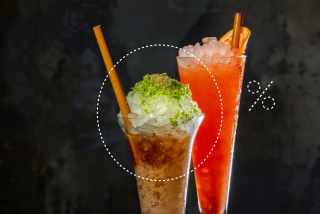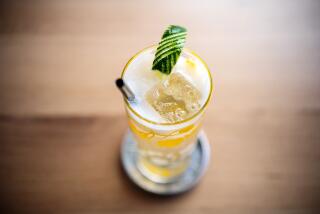The quest for finesse
- Share via
AS we stand at our bar stations for the first drill, I take a final survey of my arsenal -- a four-button soda shooter, half a dozen juices and mixers, glassware and a shelf full of liquor. I’m ready.
“Kamikaze!” shouts Dan Mackey, instructor and owner of Pacific Bartending School in Torrance. I pull out a Boston shaker and try to remember what’s next.
I’m at the school’s introductory class to learn cocktail basics, but I’m also here on a personal quest. There’s something missing in the cocktails I’m making at home -- they’re not on par with the tantalizing concoctions at so many restaurant lounges these days, where the specialty cocktail lists can be more fun to peruse than the dessert menu. Surely there’s something professional mixologists know that I can pick up -- a technique or two that will turn my cocktails from ho-hum to spectacular.
So I not only sign up for this bartending class, but also seek advice from top mixologists including Ryan Magarian, a consultant to restaurants such as Table 8; Joseph Antonishek, executive chef at Minx in Glendale; and Tim Wilson of the Wolfgang Puck restaurants. I even apprentice myself for an afternoon at Dominick’s restaurant in the same way aspiring chefs try to arrange for stages (free labor in exchange for instruction) at restaurant kitchens.
What I discover is that making a great cocktail nowadays means internalizing three basic principles. First, a good bar, like a good kitchen, is stocked with the best possible ingredients, not only peak-of-season produce, but also homemade staples. Second, simple tools used properly allow you to make the most of those ingredients. And finally, going the extra mile with thoughtful, well-chosen garnishes can make a cocktail memorable.
Whether it’s tomato juice for the Bloody Marys you’re serving at brunch or mint for the updated mojitos you’re making for a March Madness party, always “use the best you can afford, just like when you’re cooking,” says Wilson, who oversees the mixologists at Cut, Spago and other Wolfgang Puck restaurants. “You’ve heard it all before, but it’s so true, especially in cocktails with very few ingredients.”
That means just-squeezed citrus juices for margaritas and sours -- lemon and lime juice prepared no more than two hours ahead, orange and grapefruit squeezed up to a day before serving. The fruit itself should be fresh too, and should not have been refrigerated.
“I tell all my clients to start with a big bowl of fresh fruit, if nothing else,” says Magarian, whose recent revamp of Table 8’s cocktail menu introduced a Brazilian pomegranate caipirinha made with hand-pressed Persian lime juice.
In recent years, house-made staples have replaced commercial mixes in the best bars, and there’s no reason the home bartender’s pantry shouldn’t follow suit. Making your own sour mix, grenadine and cocktail onions is easy and can be done several days ahead.
For sour mix, combine equal parts fresh squeezed lemon juice and simple syrup. With the sugar, it’s more stable than pure juice and can be stored in the fridge for up to a week. Use it in recipes and also for balancing a drink that’s a touch too sweet.
Make your own grenadine once and you’ll be amazed at the difference between the sticky-sweet bright red commercial stuff and the real thing, a tasty and useful mix of fresh pomegranate juice and simple syrup. And given that a cocktail onion is the only difference between a Gibson and a martini, it’s worth making your own with sherry vinegar and juniper berries.
With my ingredients gathered (not forgetting best-quality spirits), I turn to gleaning some truths about bartending tools from the pros. In Mackey’s class, one of the most important lessons I learn is how to use a Boston shaker, the simple combination of a metal tumbler and a pint glass favored by professional bartenders. They’re fast, efficient and inexpensive, so even at home you can have several on hand as you mix up different cocktails.
Shake things up
POUR ingredients and ice into the tumbler, invert the glass on top and lightly tap the bottom of the glass to seal. Position the shaker over your shoulder -- holding firmly with your palm to maintain the seal -- and give it a vigorous 10- to 15-second shake. Tap the shaker to break the suction (never tap the pint glass or it will shatter) and strain the mixture into a serving glass.
One afternoon, when the lunch crowd has thinned, I spend a few hours behind the bar at Dominick’s in West Hollywood with Lawrence Rudolph, general manager, and Brandon Bossert, manager, the resident mixologists. Cocktails at Dominick’s are made a la minute: Juices are squeezed directly into the serving glass and garnishes are cut to order.
Rudolph and Bossert approve of my newfound penchant for pristinely fresh fruit juice and are even happier to learn I’ve mastered the Boston shaker. They suggest I take both concepts a step further and use a serving glass instead of a pint glass with the metal shaker, showing me how to muddle (i.e. mash) fruit in the same glass.
“The really cool thing about a Boston shaker is you can muddle in whatever glass you’re using to serve the cocktail. So when you strain the drink back into the same glass, you get even more flavor from the oils already in the glass,” Rudolph says.
Bossert demonstrates by muddling lime, mint and simple syrup in the serving glass, pouring the fruit and herbs into the metal tumbler, adding rum and shaking. He pours the shaken mixture back into the serving glass and adds fresh ice. Muddlers are another indispensable but inexpensive bar tool. Choose one with a long handle so it’s easy to reach inside the glass. The head should be flat and have a large surface area. Press down firmly on the muddler several times to release the oils -- the aromas will let you know it’s happening -- and extract the most flavor. Avoid using metal teaspoons because the spoon pierces the ingredients, making them bitter.
A few tips on garnishing round out my introduction to bartending technique. At home, the best strategy is to serve a few house cocktails, allowing you to plan a few creative garnishes that play up or complement the ingredients in each drink.
“It’s really the same concept as garnishing a dessert,” says Antonishek of Minx, who tops a lemon lavender martini with a sprig of lavender or a pear martini with sliced pear. “Garnishes should stay true to the flavors you’re working with in the cocktail.” Bossert and Rudolph like to use dried fruit garnishes for their concentrated flavor and jewel-like colors, such as the dried honey tangerine slices floated atop a tangerine martini. The dried fruit plumps up slightly and you can take tangy liquor-infused bites as you sip.
*
Cocktail onions
Total time: About 45 minutes
Servings: Makes 2 to 4 dozen
Note: From “Raising the Bar” by Nick Mautone
1 pound pearl onions
1/2 cup sherry vinegar
1/2 cup cider vinegar
1/2 cup salt
1/4 cup sugar
1/2 teaspoon mustard seed
24 juniper berries
12 peppercorns
6 allspice berries
1 6-inch piece fresh rosemary
1 dried chile de arbol
1 cup dry vermouth
1. Place the onions in a large bowl and pour boiling water over them to cover. Let stand for 1 minute. Drain and rinse under cold running water. Using a paring knife, trim the root ends and peel off the thin outer skins.
2. Add the vinegars, salt, sugar, mustard seed, juniper berries, peppercorns, allspice berries, rosemary and chile to a medium saucepan, stir to combine and bring to a boil.
3. Add the onions, reduce the heat, and simmer 2 minutes. Simmer larger cocktail onions (24 per pound) 2 minutes more. Allow the onions to cool in the liquid.
4. Stir in the vermouth. Transfer the cooled onions and liquid to a container with a tight-fitting lid. Allow the onions to marinate for at least 24 hours before using. Store in the refrigerator for up to 3 weeks.
Each large onion: 9 calories; 0 protein; 2 grams carbohydrates; 0 fiber; 0 fat; 0 saturated fat; 0 cholesterol; 233 mg. sodium.
*
Grenadine
Total time: About 15 minutes
Servings: Makes 1 1/2 cups
Note: Use 100% pure pomegranate juice with no added sugars, such as the Evolution brand. To make a simple syrup, heat equal parts sugar and water over medium heat until the sugar dissolves; cool.
8 ounces unsweetened pomegranate juice
6 ounces simple syrup
In a medium saucepan, bring the pomegranate juice and simple syrup to a gentle boil over medium-high heat. Reduce the heat so that the mixture simmers, stirring occasionally, until slightly reduced, about 10 minutes. It shouldn’t reduce too much or get syrupy; it should be just concentrated enough to give a little texture to the drink. Cool; store in the refrigerator for up to 10 days.
Each tablespoon: 15 calories; 0 protein; 4 grams carbohydrates; 0 fiber; 0 fat; 0 saturated fat; 0 cholesterol; 1 mg. sodium.
More to Read
Eat your way across L.A.
Get our weekly Tasting Notes newsletter for reviews, news and more.
You may occasionally receive promotional content from the Los Angeles Times.










